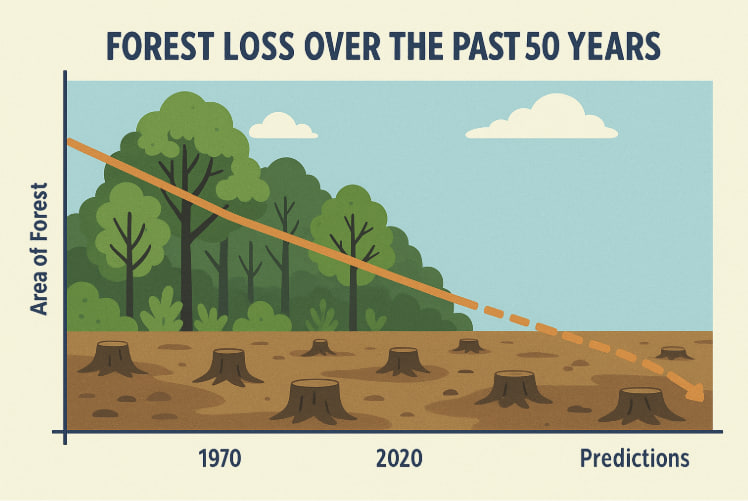Forests are essential to life on Earth, covering about 30% of the planet’s land surface. They regulate climate, house more than half of all terrestrial species, and support the livelihoods of over a billion people. Yet over the past 50 years, the world has witnessed an alarming and persistent loss of forests, threatening ecosystems, climate stability, and human well-being.
Forest Loss Since the 1970s: A Global Overview
According to data from the FAO (Food and Agriculture Organization) and satellite monitoring systems:
- The world has lost over 1.3 million square kilometers of forest since 1990—an area larger than South Africa.
- Most of this deforestation occurred in tropical regions, particularly the Amazon, Congo Basin, and Southeast Asia.
- The 1970s–1990s marked the peak of rapid deforestation, driven by agricultural expansion, logging, and population growth.
In some regions, forest loss has slowed thanks to better regulations and reforestation efforts, but in others, it continues at a dangerous pace.
Main Drivers of Forest Destruction
- Agriculture
- The biggest driver of forest loss: forests are cleared for cattle ranching, soybeans, palm oil, and subsistence farming.
- Illegal Logging and Timber Trade
- Unregulated logging contributes significantly to forest degradation.
- Mining and Infrastructure
- Roads, pipelines, and mining projects fragment and destroy forest habitats.
- Fires (Natural and Man-Made)
- Wildfires, often worsened by climate change and land clearing, destroy millions of hectares annually.
- Climate Change
- Warmer temperatures and shifting rainfall patterns weaken forest ecosystems, making them more vulnerable.
Environmental and Social Consequences
- Biodiversity loss: Forests are home to 80% of land animals and plants. Deforestation accelerates extinction.
- Carbon emissions: Trees absorb carbon dioxide; their destruction releases massive amounts back into the atmosphere.
- Water cycle disruption: Deforestation affects rainfall, river flow, and increases the risk of drought and flood.
- Indigenous displacement: Many native communities are pushed out of ancestral lands.
- Health risks: Loss of biodiversity can increase the likelihood of zoonotic diseases spreading to humans.
What Does the Future Hold?
If current trends continue:
- By 2050, up to 170 million more hectares of forest could be lost.
- Tropical deforestation may contribute to a global temperature increase of up to 0.2°C.
- Key species and entire forest ecosystems may collapse beyond recovery.
However, hopeful scenarios are possible, if the following actions scale up:
- Zero-deforestation pledges from corporations and governments.
- Sustainable agriculture and responsible consumer choices.
- Global reforestation efforts, like the Bonn Challenge and UN Decade on Ecosystem Restoration.
- Carbon credit programs that financially reward forest conservation.
The next 20 years will be crucial in determining whether forests rebound or decline further.
Glossary
- Deforestation — The permanent removal of forests to make land available for other uses.
- Reforestation — Planting trees in areas where forests have been cut down.
- Carbon sink — A natural system that absorbs more carbon than it emits.
- Biodiversity — The variety of living organisms in a specific area or on Earth as a whole.
- Zoonotic diseases — Illnesses that can be transmitted from animals to humans.


